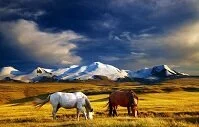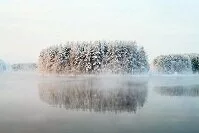Geography, Weather, & Wildlife of Russia
WARNING: Russia's border with Ukraine is unstable and tensions are high, read this travel warning before going!
Geography

Horses on Ukok Plateau
Russia is the world's largest country by size and it stretches across almost half the world. It reaches north almost to the North Pole, west into Europe, south into the Caucus Mountains and the Steppe, and in the east all the way into Asia and up to China. It borders the following bodies of water: Arctic Ocean (north), Baltic Sea (west), Black Sea (southwest), Caspian Sea (southwest), Sea of Japan (east), Pacific Ocean (east), and the Bering Sea (east) along with numerous smaller seas and bays. It also borders Norway (northwest), Finland (northwest), Estonia (west), Latvia (west), Belarus (west), Ukraine (west), Georgia (southwest), Azerbaijan (southwest), Kazakhstan (south), China (south and southeast), Mongolia (south), and North Korea (southeast). Additionally, it controls islands a short distance from both the United States and Japan, plus Russia controls the region of Kaliningrad, which sits on the Baltic Sea and borders Poland (south) and Lithuania (northeast).

Lake in Karelia
Geographically, Russia has nearly everything. Any landmass that stretches over half the earth will be diverse and Russia is no exception. European Russia (bordered by the Ural Mountains in the east) is where most of the population lives as this region is home to numerous rivers, lakes, and lowlands. Asian Russia (east of the Ural Mountains) is very inhospitable as much of this region is at elevation and receives little rain. This area also boasts most of Russia's geographic diversity as there are numerous mountain ranges, long isolated rivers, and some large lakes. As a whole, Russia's diversity ranges from swampland in much of the north to alpine peaks in the Caucus Mountains and huge lakes such as Lake Baikal in Siberia to volcanic ranges like the Kamchatka Peninsula.